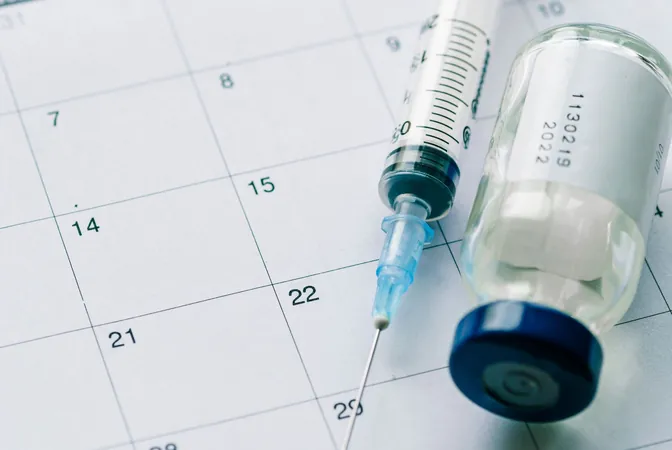
Exciting Developments in Metastatic Breast Cancer: New ADCs on the Block!
2025-04-03
Author: Wei Ling
Introduction
In a groundbreaking achievement for breast cancer treatment, the FDA has recently approved two new antibody-drug conjugates (ADCs): fam-trastuzumab deruxtecan-nxki (T-DXd; Enhertu) and datopotamab deruxtecan-dlnk (Dato-DXd; Datroway). This expansion is a game-changer for hormone receptor-positive (HR+) metastatic breast cancer patients, now offering clinicians three powerful ADC options and raising important questions about treatment sequencing and future advancements in this field.
During the recent OncLive® State of the Science Summit™, Dr. Sara Nunnery, a leading oncologist at Tennessee Oncology in Nashville, discussed pivotal insights from clinical trials that involved both of these ADCs. Most notably, the phase 3 DESTINY-Breast06 (NCT04494425) and TROPION-Breast01 (NCT05104866) studies provided critical data supporting these approvals.
The FDA gave the green light for T-DXd to be used in cases of HR-positive, HER2-low or ultralow breast cancer in patients who have progressed after at least one endocrine therapy. Similarly, Dato-DXd received approval for use in patients with unresectable or metastatic HR-positive, HER2-negative breast cancer after prior treatment with endocrine-based therapy and chemotherapy.
The Power of T-DXd in Targeting Breast Cancer Cells
T-DXd, primarily developed for HER2-positive breast cancer, has shown remarkable effects even in HER2-negative or low HER2 types. The drug operates via a dual mechanism — not only directly killing cancer cells that absorb the ADC but also affecting nearby cells, enhancing its therapeutic efficacy. Approved for use before traditional chemotherapy in specific types of HR-positive breast cancer, T-DXd has dramatically broadened its patient eligibility.
In recent findings from the DESTINY-Breast06 trial, T-DXd treatment resulted in a staggering 5.1-month increase in progression-free survival (PFS) compared to traditional chemotherapy, solidifying its role as a frontline therapy.
Safety Considerations: Monitoring What Matters
While the benefits of T-DXd are clear, there remains a need for vigilance regarding potential side effects. Dr. Nunnery noted that patients may experience nausea, fatigue, and in rare cases, severe interstitial lung disease (ILD) or pneumonitis. Understanding these risks is pivotal as healthcare providers adopt these therapies, ensuring patient safety remains a top priority.
Next-Gen ADC: Dato-DXd Steps Up
The approval of Dato-DXd marks another milestone in ADC therapy, targeting TROP2, an antigen widely expressed in breast cancer. In the TROPION-Breast01 trial, Dato-DXd outperformed traditional chemotherapy, showing a median PFS of 6.9 months compared to just 4.9 months with chemotherapy. Importantly, Dato-DXd has a more favorable safety profile, causing fewer blood count issues, greatly reducing the risk of serious infections often associated with chemotherapy.
Yet, it’s essential to remain aware of potential side effects unique to Dato-DXd, such as stomatitis and ocular irritation, making close monitoring and patient education crucial components of treatment.
Where Do We Go From Here? The Future of ADCs in Breast Cancer Treatment
As cancer treatment evolves, many questions remain about the optimal sequencing of ADC therapies. Dr. Nunnery expressed that ongoing research is key to identifying the best treatment pathways and adapting to each patient’s unique needs. Current guidelines lack definitive answers, but healthcare providers are committed to tailoring treatments based on individual patient goals and responses.
Looking ahead, there is a palpable excitement in the community regarding the advent of new ADCs that utilize different payloads and target new antigens. Ongoing clinical trials exploring HER3-targeted ADCs and those with microtubule inhibitor payloads promise innovative treatments that may combat any resistance these current therapies may encounter.
As we beckon in this new era of targeted therapies, the potential impact on patients with metastatic breast cancer is profound, with hope for more effective treatments and improved quality of life on the horizon.
Stay tuned to witness the evolution of breast cancer treatment and the innovative strategies reshaping patient care.




 Brasil (PT)
Brasil (PT)
 Canada (EN)
Canada (EN)
 Chile (ES)
Chile (ES)
 Česko (CS)
Česko (CS)
 대한민국 (KO)
대한민국 (KO)
 España (ES)
España (ES)
 France (FR)
France (FR)
 Hong Kong (EN)
Hong Kong (EN)
 Italia (IT)
Italia (IT)
 日本 (JA)
日本 (JA)
 Magyarország (HU)
Magyarország (HU)
 Norge (NO)
Norge (NO)
 Polska (PL)
Polska (PL)
 Schweiz (DE)
Schweiz (DE)
 Singapore (EN)
Singapore (EN)
 Sverige (SV)
Sverige (SV)
 Suomi (FI)
Suomi (FI)
 Türkiye (TR)
Türkiye (TR)
 الإمارات العربية المتحدة (AR)
الإمارات العربية المتحدة (AR)